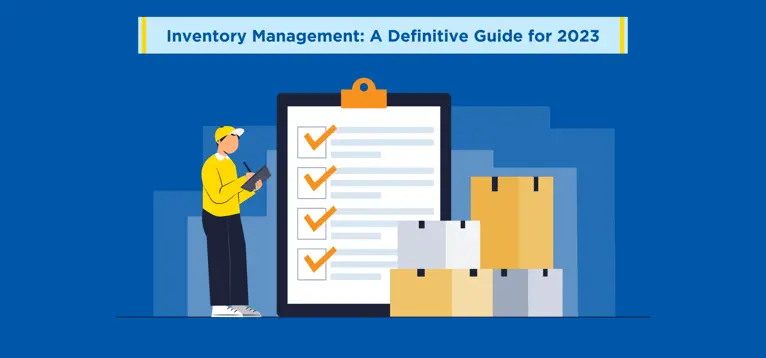The logistics industry is pushing its boundaries every day to make every product available to the customer at the earliest at any location.
But to do that, it needs to figure out the art of effective inventory management. It plays a central role in fulfilling the expectations of today’s consumers.
Inventory management is the heart of a product-driven business since it decides the cash inflow and keeps the customers coming back to purchase from you.
Considering that inventory is the foundation of your online or retail store, it’s critical to pay heed to manage it to maximise revenue without overextending resources.
The following article talks about everything you need to know about inventory management in the current supply chain framework that is dominated by volatile markets and changing technologies.
What is Inventory Management?
Inventory Management is the act of tracking and managing the stock units as they move across the supply chain. The goal of any organisation is to manage its inventory in a way that there is adequate supply without being out of stock or having an unnecessary surplus.
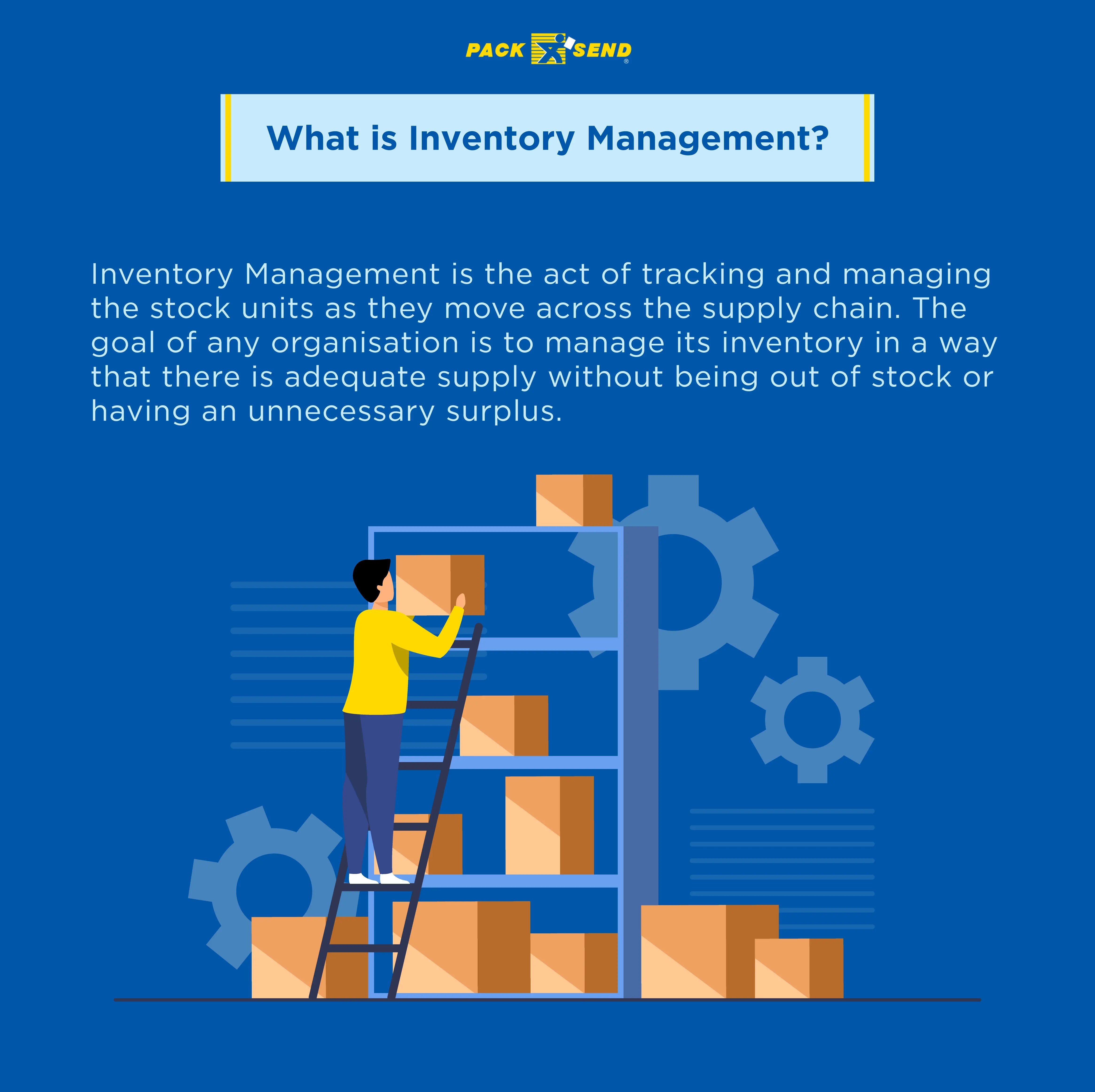
4 Types of Inventory
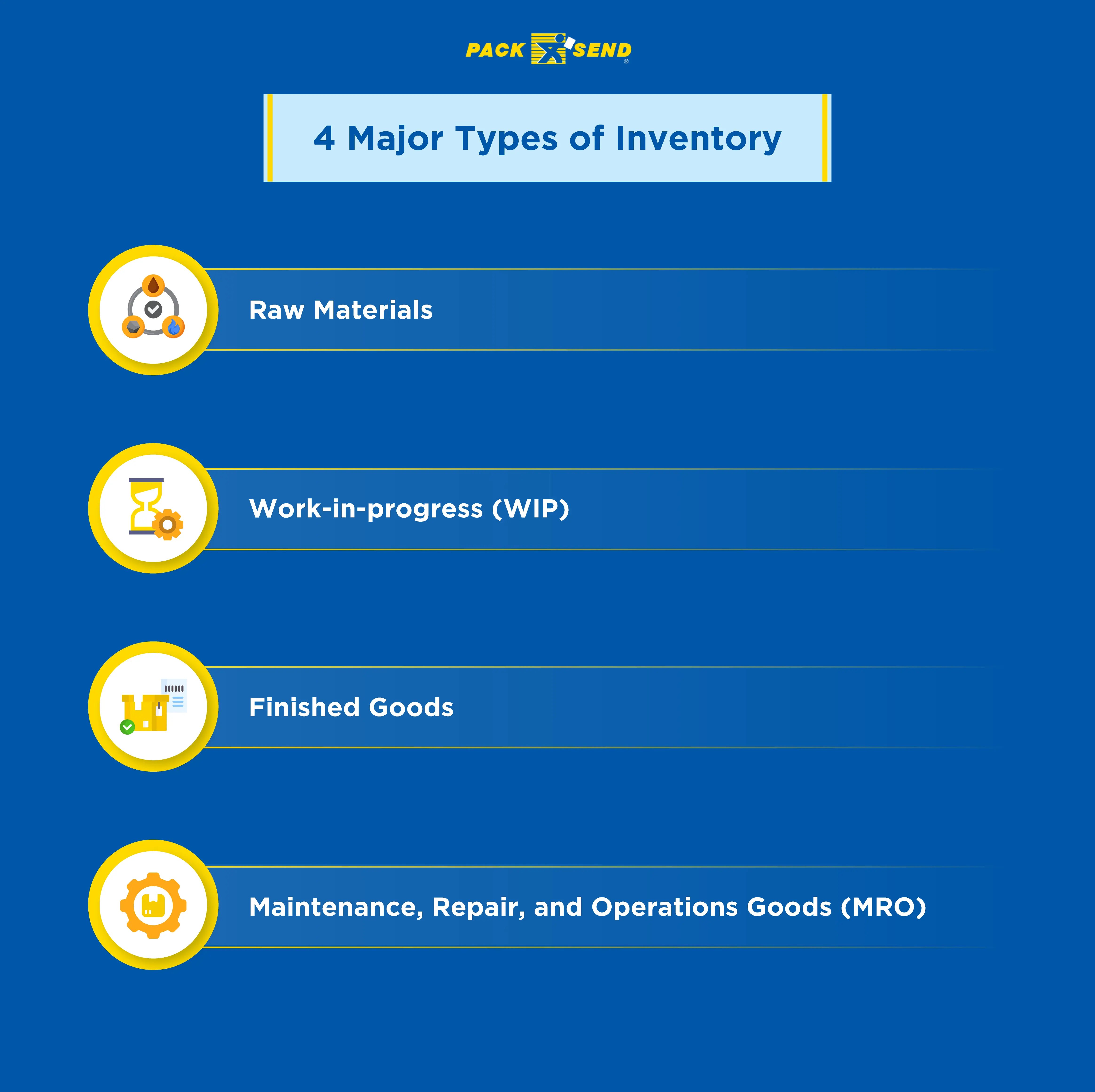
1. Raw Materials
Raw materials or raw goods are those that are used in production. They include wood, plastics, and fabrics, basically, the goods that are primarily used in the creation of finished products. The inventory management for raw materials is done early on in the supply chain when a business owner acquires these materials from one or more suppliers and stores them for production.
2. Work in process (WIP)
As raw materials are in the process of becoming finished goods, they turn into work in process inventory. These are partially completed inventory that requires different storage requirements. In accounting, these also include production costs, labour, and machinery.
However, it is only included in the production stage. Once they turn into finished goods, they’re attributed to sales cost.
3. Finished Goods
These include the final output that is ready for the customer to buy. Finished goods inventory management is usually done at the finishing end of the supply chain where goods are stored and picked up for delivery to the end consumer.
4. Maintenance, Repair, and Operations Goods (MRO)
A lot of goods and items go into the process of turning the raw materials into a finished product. These include manufacturing gear, cleaning supplies, office supplies, etc. These all materials fall into the maintenance, repair, and operations supplies of goods.
4 Crucial Benefits of Inventory Management
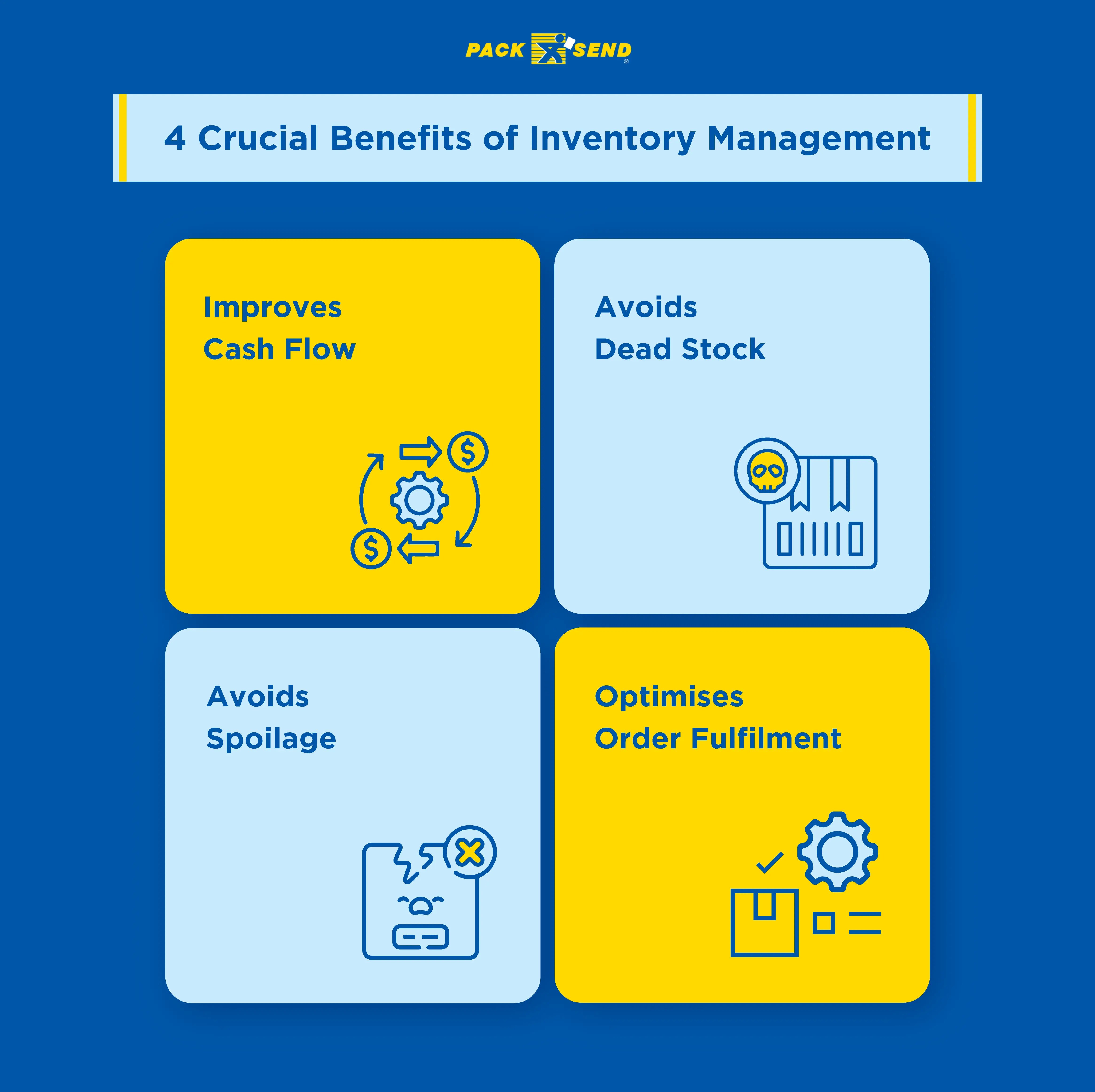
1. Improves Cash Flow
Inventory directly affects your sales. Accurate inventory management defines how much you can sell and what raw materials you have to buy. The movement of inventory enables a free flow of cash considering the payment and sales you make. Both these elements factor heavily into how much cash you have on hand.
Stocks sitting idle are blocking the money you spent on inventory. Inventory management helps you cut money on housing unnecessary items that block the cash flow, and ensures liquidity where you need it the most. Naturally, careful calculation of the inventory results in higher liquidity and cash flow across the supply chain.
2. Avoids Dead Stock
You don’t want to pay for inventory that isn’t going to sell. Inventory management practices like demand forecasting give you an insight into how much inventory you will need at a particular point in time. This eliminates any scope of having dead stocks.
Dead stock is any unsold item that is lying in your warehouse or your store for a long time. It’s either because the product has gone out of season, or style or become irrelevant. With the right inventory data management and predictions, inventory management can address this cost-heavy inventory mistake.
3. Avoids Spoilage
A lot of products come with an expiration date. Food and beverages are the perfect examples. You have to sell them within a specific time frame or else they can no longer be consumed. If you’ve aced your inventory management, it becomes a cakewalk to know just how much inventory you need to keep to avoid spoilage and sell the products in the acceptable window.
4. Optimises Order Fulfilment
You don’t ever want to be in a situation where a customer places an order on your eCommerce store and you don’t have the product available. Efficient inventory management allows multiple eCommerce fulfilment centres to ensure that the distribution centres are closer to your customers. It speeds up the delivery process and reduces shipping costs leading to higher customer satisfaction.
Inventory Management also helps you track your inventory through inventory management systems. It helps online stores and large retailers to consolidate data from multiple order fulfilment centres and close out an entire individual warehouse operation.
7 Techniques of Effective Inventory Management
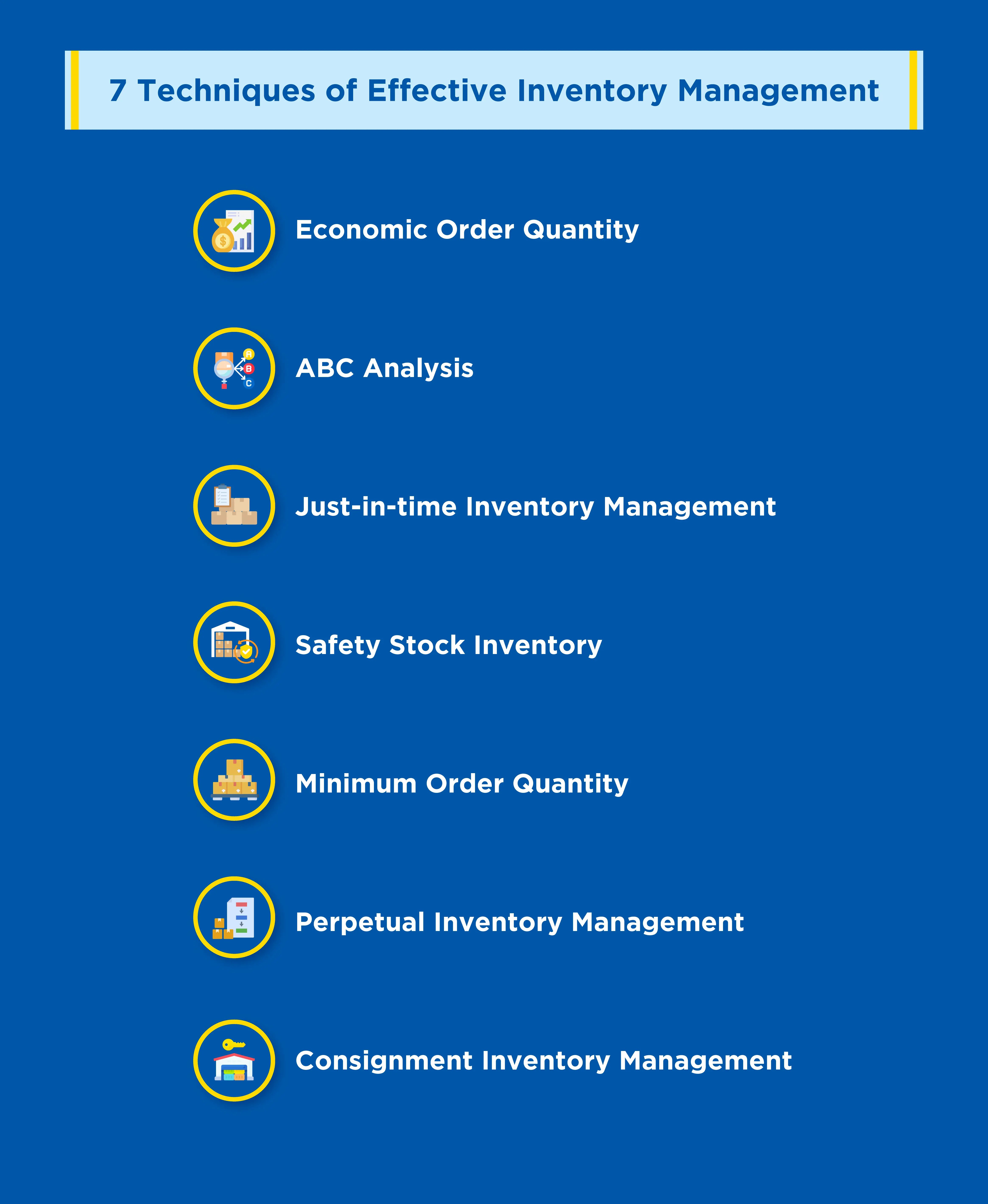
What do you do once the goods are finished and ready to be sold? How do you store them? How do you decide which one to sell first? How do you keep track of the exact quantities and qualities of each stock unit?
To answer these questions, you have inventory management techniques that help in tracking and controlling inventory orders. You can assess their usage, and storage, and manage goods that are ready to be sold.
1. Economic Order Quantity
This technique focuses on making a decision of how much inventory a company should purchase considering the total costs of production, demand rate, and other factors. Economic order quantity gives you the highest number of units which helps you minimise buying and save ordering costs and carrying costs incurred while placing the order.
The store manager or the online store only reorders inventory when it reaches the reordering level. The model evaluates the trade-off between the cost of ordering and the cost of carrying inventory.
2. ABC Analysis
ABC is short for Always Better Control analysis — an inventory management technique where the goods are classified into three categories based on their value. Items in the A category include high-priced items which may be less in quantity. Items in the B category include comparatively less expensive items as compared to category A.
Lastly, the last category consists of inventory that doesn’t have a high value. The C category requires the least level of control and the A category requires a high level of control. ABC analysis also considers the demand, cost, and risks associated with inventory and groups them into categories. This method helps inventory managers to decide which items to stock, how much to stock, and when to order new inventory.
3. Just-in-time Inventory Management
In this method, companies receive inventory as per their production needs instead of ordering too much or too less. Due to the lack of dead stock, the company saves on the cost of storage and insurance. It orders new inventory when it almost exhausts the old inventory.
It is slightly risky to follow this method since your supply chain can be disrupted if the goods ordered at the last moment are not delivered leading to a stock-out situation.
Stock managers need to accurately plan so that new orders can be placed at the right time. Businesses typically align their inventory orders from suppliers directly with their production schedules. If they get the hang of it, this method eventually improves their overall efficiency and profitability.
4. Safety stock Inventory
Stock managers usually order extra inventory and set them aside in case they face any inventory shortages. This inventory management method is known as safety stock inventory.
For example, even if a business requires just 20,000 units of inventory at a moment, they place an order for 25, 000 units to have a safety stock of 5000 units and have a minimum safety stock level. A big benefit of this is that it typically creates a safety net in events of stock-outs caused by inaccurate forecasting and unexpected changes in demand.
5. Minimum Order Quantity
Minimum Order Quantity (MOQ) is the smallest amount of inventory that an online or retail store will purchase in order to keep the costs at a minimum and also to keep the relationship active with suppliers. If the order amount does not reach the MOQ threshold, they won’t accept and fulfil your order.
Minimum order quantity is a boon for suppliers since they do in-bulk shopping, secure faster turnover, and earn profits. Retailers need to keep in mind that the inventory that costs more to produce has a smaller minimum order quantity as compared to items that are cheaper to produce.
6. Perpetual Inventory Management
A perpetual inventory system is a technique where you record sales, purchasing, and inventory usage in real-time through inventory management tools or ERP software. The purpose is to get real-time insight into the inventory as soon as the inventory arrives.
Although you can record this manually or via a spreadsheet, most businesses automate the process through an inventory system. It automatically records the balances as soon as the stock is moved, sold, or used.
Inventory management systems offer a benefit over traditional tools since it automates the mundane process of recording and controlling inventory. It takes away the hassles of getting real-time information and accessing data that eventually helps businesses avoid stockout situations and lose sales. It also helps by improving visibility across supply chains and reducing inventory and storage costs.
7. Consignment Inventory Management
Consignment Inventory Management is an inventory management technique where a retailer doesn’t buy the inventory from the supplier until it’s sold. The vendor agrees to give the consignee their goods without the consignee paying for the goods upfront like it's usually done. Consignment stock usually includes goods that are:
- Seasonal
- Perishable
- Previously owned
This poses a huge benefit for the sellers since they don’t have to incur the costs of unsold goods, nor do they have to commit to selling a product with no history. Unsold inventory can simply be returned to the vendor or the wholesaler. With this technique, retailers also enjoy the benefits of offering a broader range of products without blocking their capital in inventory.
As for wholesalers, they can reduce the burden of marketing costs of the products by transferring them to retailers and also testing new products at the same time. If they sell well, they can eventually shift to a more conventional inventory management system.
7 Best Practices for Inventory Management
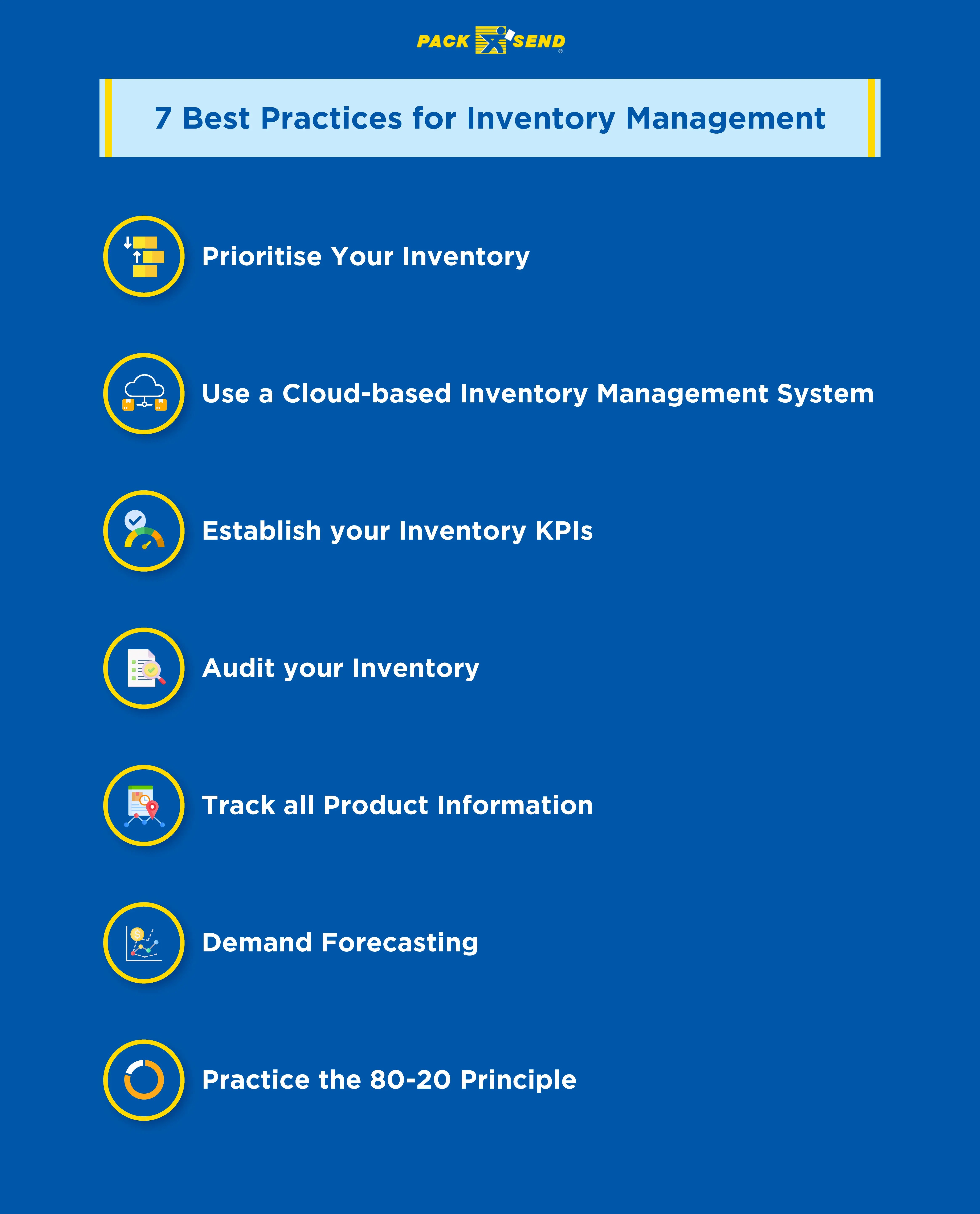
With so many types of inventory and too many methods, it is natural for a business to get overwhelmed with managing its supply chain. It takes time to perfect the art of having just the right amount of inventory to save costs and maximise sales. Meanwhile, here are some tips that you can implement to improve your inventory management.
1. Prioritise Your Inventory
It’s important to prioritise your inventory based on the ABC analysis we discussed before. ABC technique helps you arrange your inventory into a hierarchy of most important stocks to least important ones.
You can allocate space and prioritise inventory that falls in the A category since they are the best-selling stock, require constant quality review, and require regular reordering.
It also saves you time from allocating time to B and C category stocks that don’t regularly require reorders or are of high value. Organising your stock according to these priorities shows how you can optimise your warehouses and streamline order fulfilment. Some other benefits include:
- Increased Inventory forecasting: If you can prioritise products that have high consumer demand, you can predict the sales and use that information to set the inventory levels in the future.
- Better pricing: Prioritising inventory helps you gauge which items are more profitable so that you can focus on enhancing sales and adjusting your price according to the demand.
- Better Supplier Negotiations: Companies earn the majority of their revenue from class A items. If you have figured out what these items are, you can negotiate better terms with suppliers for these particular items, like ordering them in bulk, down payment reductions, free shipping, etc.
2. Use a Cloud-based Inventory Management System
Manual inventory management is a “big no” in today’s time. Since companies are operating globally, the idea of manual inventory management is almost impossible. Consider the multiple warehouses, worldwide shipping, and the complexity of tracking global supply chains.
You need to make use of cloud-based inventory management systems that help you automate inventory management in core areas to manage the volume and scale of your inventory. Also, when you automate, you need to look for systems that give you access to the features you need.
Cloud-based inventory management software holds the upper hand when it comes to having advanced features. These very features help warehouses with order fulfilment and inventory tracking during manufacturing, storage, and distribution.
Besides, inventory management systems have greatly advanced over the years. They can now accurately predict demand, simplify placing orders, and increase product traceability for everyone involved in the supply chain process, thereby, allowing you to analyse key performance indicators of your suppliers.
With the right inventory management system, you can transform your entire warehousing, shipping, and supply chain operations for the better. It pools everyone from your team to use these tools on a wide variety of devices regardless of where they are located.
3. Establish Your Inventory KPIs
With all the efforts that you put into managing your inventory, you also need to know how good of a job you’re doing. You need to establish Key Performance Indicators (KPIs) in inventory management. These metrics will help you monitor and track your progress allowing you to make decisions about your stocks.
KPIs also give insights into turnover, sales, demand, costs, relationships, and more. You can track them via the inventory management software itself. Some of the top metrics you should consider are:
Sales KPIs
You need to measure Sales KPIs to get a powerful context to gross sales data. You get that by calculating inventory formulas and getting a more detailed understanding of sales performance. Some of the metrics included under sales KPIs are:
- Inventory Turnover Rate
- Sell-through Rate
- Stock to Sale Ratio
- Days Sales in Inventory
Receiving KPIs
Since the supply chain is a lengthy and complex process, receiving inventory is calculated separately from warehouse inventory. Receiving KPIs allows you to evaluate warehouse management performance and its efficiency in controlling inventory as soon as it arrives. The KPIs you should calculate are:
- Time to Receive
- Putaway Time
- Supplier Quality Index
Operations KPIs
These KPIs give you an overview of how well your supply chain functions are performing. They give you a comprehensive view of your operations and how they are impacting the end consumer. Some metrics you should calculate are:
- Perfect Order Ratio
- Lost Sales Ratio
- Supplier Quality Index
- Rate of Returns
- Customer Satisfaction Score
4. Audit your Inventory
Logistics companies and warehouses usually have a fixed time once or twice a year when they count everything and compare the physical counts to their numbers as they reset for the upcoming financial year. Here are some of the ways you can conduct the audit:
Physical Inventory
A physical inventory audit means manually counting every item in the inventory. You can then align these numbers with the expected numbers in the inventory system. Counting physical inventory helps you identify when to order new supplies.
Spot Checks
Physical inventory is great but it’s not scalable. So stock managers adopt spot checks where they randomly pick products from the entire inventory to physically inspect them and compare them to match them to the information in the shipping software for order fulfilment.
Cycle Counting
Cycle counting is similar to physical inventory counting but the process is distributed across the course of the year. Each product has its own audit period. However, once you divide your products according to the ABC analysis, ensure you conduct regular audits for high-value items.
Audits are time-consuming and a nightmare. To avoid large issues at the year's end owing to the inventory, it’s ideal to adopt cycle counting and do more frequent audits. It can make auditing inventory easier and allows you to have larger control over inventory management.
5. Track all Product Information
Your inventory is always on the move and getting handled by different entities across the supply chain. To keep everyone in the loop, it’s ideal to make your product trackable. You can also track products in batches. To do so, you can use an automatic batch tracking system in order to enter information about the products. It helps you access the information at your time of need.
Make sure that you keep records of the product information such as SKUs, barcode data, countries of origin, and batch numbers. You can consider keeping a record of the costs as well. It helps you prepare for changes, increasing demand or scarcity.
6. Demand Forecasting
One of the biggest benefits of automating your inventory management is having easy access to data that you otherwise wouldn’t be able to fetch. Demand forecasting is the process of evaluating the required inventory in the future by leveraging previous data, trends, and occurrences to make better decisions and have enough inventory when the consumer demands.
The purpose of demand forecasting goes beyond just knowing when to reorder. Forecasting puts all data to good use to predict changing consumer habits, trends, and customer preferences.
Advanced inventory management systems leverage artificial intelligence to predict the demand for inventory based on previous practices and current data. Even just having a slight idea of how your inventory will be used in the future, you can better prepare the stock-keeping units, avoid dead stocks, and maximise profits.
7. Practice the 80-20 Principle
If you’re in the inventory game for long enough, you’d know that there is some 20% of your good that drives around 80% of the revenue. The 80-20 principle, also known as the ‘Pareto Principle’ is a way to make inventory management easier.
You should understand and pay heed to the sales lifecycle of these items and monitor how much you sell weekly, monthly and yearly. The idea is to prioritise the sales of these 20% items and practices that produce the most return on investment so that you fetch a better result with less effort.
Future of Inventory Management
As technology progresses, it’s essential for companies to brace themselves for the changes that will be introduced in the supply chain process and inventory management. Some of the top trends that the industry should look out for are:
RFID
Radio Frequency Identification technology is already widely used in inventory management. Warehouse managers are using RFID tags to find, dispatch, and control inventory across the supply chain.
AI
Cloud-based inventory management systems that we spoke about are equipped with AI abilities. AI is used to gain new applications, automate decisions and meet consumer expectations in real time. It is because of AI that freight service providers are able to match the quick delivery expectations of the consumers since it helps in optimising order fulfilment and reducing delivery times across the supply chain.
IoT
Internet of Things (IoT) devices will continue to become more prominent in inventory management since it reduces the time in providing real-time data. It also helps you make informed decisions based on the amount of stock you have.
Wrapping Up
Inventory management has evolved over the years. Regardless of what kind of store you own, inventory management is always going to be an activity you have to pay attention to reduce costs, improve supply chain efficiency, and maximise returns.
For efficient inventory management, you need an efficient 3PL warehouse storage partner. PACK & SEND can provide you with just the right amount of storage whilst offering stock management and order fulfilment services.
You can trust PACK & SEND to take over fulfilling your customer orders on time and effectively handling stock inventory. Contact us for more information on how we can help you organise your inventory.
Frequently Asked Questions (FAQs)
What is the difference between Inventory and Stock?
Stock only refers to the finished goods that are ready to be sold to the consumer. Whereas inventory includes raw materials, and work-in-process units as well. However, if the raw material is a finished good that is sold to the end-consumer, it falls in stock.
How to reduce Inventory Costs?
Inventory is heavy on the pocket if not managed properly. To avoid any costs associated with excess inventory, ensure that there is no dead stock lying around, you’re only paying for the space you need, and reduce supplier lead time.
The best way to get accuracy in managing inventory is to adopt an inventory management system through which you can identify gaps, and determine the amount of stock you’ll need at a particular time.
What Is an Inventory Management System?
An inventory management system is a collection of different software features that are used for tracking inventory and stock levels and their movements across the supply chain. The solution is compatible across multiple fulfilment centres and sales channels.
How is inventory management different from warehouse management?
Warehouse management only includes monitoring, regulating, and optimising inventory movement within the parameters of a warehouse. Inventory management is doing these activities across the supply chain. In simple words, warehouse management is simply a part of the inventory management process as a whole.
